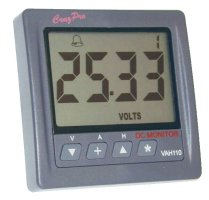davisr
Member III
Just wondering if anyone has had any experience with the xantrex linklite. I'm interested in using it to monitor the charge on a 225 ah bank of 6v Trojan T-105 batteries.
Thanks,
Roscoe
PRODUCT INFORMATION
[FONT=Verdana, Arial, Helvetica, sans-serif][SIZE=-1]LinkLITE Battery Monitor
Battery Status At A Glance
The LinkLITE battery monitor can measure currents up to 1,000Amps. It selectively displays voltage, charge and discharge current, consumed amp hours and remaining battery capacity. It is equipped with an internal programmable alarm relay, to run a generator when needed or to turn off devices when the battery voltage exceeds programmable boundaries.
Description
Defining the amount of energy available in a battery is a complex task since battery age, discharge current and temperature all influence the actual battery capacity. High performance measuring circuits, along with complex software algorithms, are used to exactly determine the remaining battery capacity. A new shunt selection feature enables the LinkLITE to measure currents up to 1,000Amps respectively.
The LinkLITE selectively displays voltage, charge and discharge current, consumed amp hours and remaining battery capacity. Using a clear backlit LCD Display and an intuitive user interface, all parameters can be recalled with just a button press. A second battery input is also provided to monitor voltage on a second battery.
It is equipped with an internal programmable alarm relay, to run a generator when needed or to turn off devices when the battery voltage exceeds programmable boundaries.
Performance Features
Thanks,
Roscoe
PRODUCT INFORMATION
[FONT=Verdana, Arial, Helvetica, sans-serif][SIZE=-1]LinkLITE Battery Monitor
Battery Status At A Glance
The LinkLITE battery monitor can measure currents up to 1,000Amps. It selectively displays voltage, charge and discharge current, consumed amp hours and remaining battery capacity. It is equipped with an internal programmable alarm relay, to run a generator when needed or to turn off devices when the battery voltage exceeds programmable boundaries.
Description
Defining the amount of energy available in a battery is a complex task since battery age, discharge current and temperature all influence the actual battery capacity. High performance measuring circuits, along with complex software algorithms, are used to exactly determine the remaining battery capacity. A new shunt selection feature enables the LinkLITE to measure currents up to 1,000Amps respectively.
The LinkLITE selectively displays voltage, charge and discharge current, consumed amp hours and remaining battery capacity. Using a clear backlit LCD Display and an intuitive user interface, all parameters can be recalled with just a button press. A second battery input is also provided to monitor voltage on a second battery.
It is equipped with an internal programmable alarm relay, to run a generator when needed or to turn off devices when the battery voltage exceeds programmable boundaries.
Performance Features
- Read your battery bank like a fuel gauge
- Provides critical information about the status of your battery bank
- Displays voltage, current, consumed amp hours and remaining battery capacity
- Two battery inputs
- Auto sensing battery voltage inputs
- Large backlit LCD Display
- Quick nut mounting construction
- Programmable alarm relay
- Shunt selection capability enables flexible system integration
- Splash proof front panel
- 500 Amp shunt included
- CE and e-mark certified

![33711[1].gif](/ie/data/attachments/5/5289-c308f075aca8310e0b39a849fa34353e.jpg)



 BTW were the DVM differences due to where on wires you measured or the leads from the DVMs or calibration problems in the DVMs themselves ?
BTW were the DVM differences due to where on wires you measured or the leads from the DVMs or calibration problems in the DVMs themselves ?